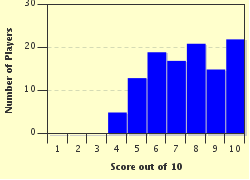Quiz Answer Key and Fun Facts
1. On March 1st 1867, which newly populated mid-western territory became the 37th state of the United States of America?
2. The Papal Conclave of 1939 came to a successful conclusion on March 2nd, with the election of Cardinal Eugenio Pacelli to the papacy. What regnal name did Cardinal Pacelli adopt?
3. The Statute of Rhuddlan, believed to have been enacted on March 3rd 1284, set out the policy for the governance of which country following its conquest by England's King Edward I?
4. Which major US city, known for a 'Great Fire', the St Valentine's Day Massacre and the 'L' transport network, was first incorporated on March 4th 1837?
5. March 5th 1824 saw the outbreak of the first war in a series of three that eventually resulted in the British annexation of which south-east Asian nation?
6. The trial of which infamous Cold War spies began in New York on March 6th 1951?
7. On 7th March 321 AD, a Roman Emperor decreed that "On the venerable day of the Sun let the magistrates and people residing in cities rest". Who, by this decree, introduced Sunday as a day of rest across the Roman Empire?
8. The Treaty of Roskilde, signed on March 8th 1658 (according to the Gregorian calendar), resulted in the united kingdoms of Denmark and Norway ceding large tracts of territory to which other nation?
9. On March 9th 1796, Napoleon Bonaparte made an important personal decision when he married his first wife - an older widow with two children. What was the name of this lady who went on to become the first Empress of the French?
10. "Mr. Watson...Come here...I want to see you" were the first words to be transmitted by telephone. Who uttered this famous phrase on March 10th 1876?
Source: Author
Fifiona81
This quiz was reviewed by FunTrivia editor
bloomsby before going online.
Any errors found in FunTrivia content are routinely corrected through our feedback system.

